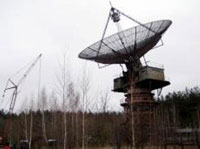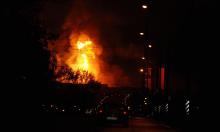Seven Technological Wonders Abandoned after USSR's Collapse
The tourist portal Turist.rbc.ru prepared a rating of impressive attractions that were abandoned after the collapse of the USSR. Once-powerful communist empire spared no means on defense or science. Huge antennas aiming at space and secret military bunkers hiding in the woods were spread out from the Pacific Ocean to the central Europe.

After the collapse of the USSR, the successors could not afford maintenance of those attractions. The newly formed countries were not interested in science, and the task of the borders protection was assigned to their powerful neighbors, Topnews reports.
Here are a few of thousands of structures hidden in the mountains and woods. These structures characterize the power of the collapsed empire. These are the least valuable structures unclaimed during the division of property between once-fraternal republics, says Turist.rbc.ru.
The top spot of the rating is given to a secret submarine base in a small Crimean town of Balaklava. This is one of the largest military objects abandoned after the collapse of the USSR.
Click here to see pictures of the abandoned miracles of the USSR
Since 1961, the complex that served for weapons storage (including nuclear) and submarines repair was located near Tavros Mountain. The dock base could shelter up to 14 submarines of various classes, and the entire complex could withstand a direct hit of a nuclear bomb with the capacity of up to 100 kT. Abandoned in 1993, the site was pulled apart for scrap metal by local residents. Only in 2002, the remnants of the submarine base were turned into a museum complex.
Abandoned Rocket Test Bay, Kekava, Latvia
After the collapse of the empire, the young republics inherited many military objects, including launching tubes of ballistic missiles scattered in the woods. The remnants of a missile complex Dvina are located near the capital of Latvia. Built in 1964, the structure contained four silos some 35 meters deep and underground bunkers. Many of the premises are now flooded, and visitors are recommended to have an experienced guide accompanying them in the launcher. The remaining toxic rocket fuel also poses a threat.
Giant Excavators, the Moscow Region
Until 1993, the Lopatinsky Phosphorite Mine was quite a successful operating mine used for the extraction of resources necessary for the Soviet agricultural sector. With the advent of market economy, the abandoned borrow pits with giant bucket excavators have become a place of pilgrimage for tourists. One should hurry to visitthis place since the huge mechanical dinosaurs are gradually dismantled for scrap. Yet, even after the dismantling of the latest technology, Lopatinsky borrow pits will remain quite a remarkable place.
Over-the-Horizon Radar Arch, Pripyat, Ukraine
The titanic structure built in 1985 to detect launches of intercontinental ballistic missiles could have functioned successfully up to this day. Yet, it operated for less than a year. Giant antenna 150 meters high and 800 meters long consumed so much electricity that it was built nearly immediately adjacent to the Chernobyl nuclear power plant. Naturally, the structure ceased its operation when the station exploded. These days, excursions are conducted here, but only few people are willing to take a risk and climb the antenna.
Ionosphere Study Station, Zmiev, Ukraine
Right before the collapse of the Soviet Union, an ionospheric research station was built near Kharkov, Ukraine. The station was a direct copy of the American HAARP project in Alaska functioning to this day. The station complex included several antenna fields and a giant parabolic antenna 25 meters in diameter, capable of radiating power output of 25 MW. The young Ukrainian state had no need in this advanced, expensive scientific equipment. Once a secret station, the object is now only visited by stalkers, hunters for non-ferrous metals, and tourists.
Abandoned Elementary Particle Accelerator, the Moscow Region
In the end of 1980s, the agonizing Soviet Union decided to build a huge elementary particle accelerator. The ring tunnel 21 kilometers long located 60 meters under the ground is still located near Protvino, a town of nuclear physicists less than a hundred kilometers from Moscow.
The tunnel was ready for the equipment, but a number of political events occurred, and the Russian hadron collider was left to rot underground.
Sea Town “The Oil Rocks”, Azerbaijan
The Soviet Union needed oil. In the 1940s, the oil extraction started 42 kilometers east of the Absheron geological trend. A town was built on metal piers and landfills around the first oil rigs.
In times of plenty, power plants, nine-storied dorms, hospitals, bakeries, and even lemonade plant were built in the open sea 110 kilometers from Baku. The Oil Rocks even features a small park with real trees. The town has over 200 stationary rigs, and its streets spread for 350 kilometers. However, cheap Siberian oil made the sea extraction unprofitable, and the town is becoming deserted. Today, it has only two thousand residents left.
Subscribe to Pravda.Ru Telegram channel, Facebook, RSS!





